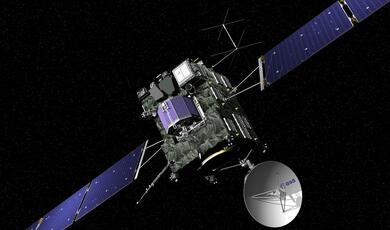Large telescopes and why we need them
Share
- Details
- Transcript
- Audio
- Downloads
- Extra Reading
Beyond the Solar System, all astronomers have to work with is the light that falls to the Earth from distant cosmic objects. Newer, larger telescopes are always needed to boost scientific progress, and the next generation of facilities - whether the 42m diameter optical-infrared Extremely Large Telescope, or the Square Kilometre Array of radio dishes - will represent a huge advance. We shall look at the science driving the need for such large telescopes, through history and to the present-day and beyond. Many scientific and engineering challenges are involved in the design and construction of the largest telescopes and their mirrors, and technological developments will be essential to their success.
Download Transcript
9 May 2012
Large Telescopes
And Why we Need Them
Professor Carolin Crawford
Astronomy is a comparatively passive science, in that we can’t engage in laboratory experiments to investigate how the Universe works. To study any cosmic object outside of our Solar System, we can only work with the light it emits that happens to fall on Earth. How much we can interpret and understand about the Universe around us depends on how well we can collect and analyse that light. This talk is about the first part of that problem: how we improve the collection of light.
The key problem for astronomers is that all stars, nebulae and galaxies are so very far away that they appear both very small, and very faint - some so much so that they can’t be seen without the help of a telescope. Its role is simply to collect more light than the unaided eye can, making astronomical sources appear both bigger and brighter, or even just to make most of them visible in the first place. A new generation of electronic detectors have made observations with the eye redundant. We now have cameras to record the images directly, or once it has been split into its constituent wavelengths by spectrographs. Even though there are a whole host of ingenious and complex instruments that enable us to record and analyse the light, they are still only able to work with the light they receive in the first place. The telescope has remained the single most important tool of an astronomer for over 400 years.
Having a wide variety of telescopes and detectors also allows us to collect all the light that astronomical objects emit, and to explore the electromagnetic spectrum to wavebands other than those to which the human eye is sensitive. Multi-wavelength observations have opened up only since World War II, as expertise originally developed for radar and rocketry was applied to astronomy. In this talk I shall be concentrating only on telescopes that work primarily at visible wavelengths; the other astronomies are reserved for future Gresham lectures, such as my talk on X-ray astrophysics later this year in November.
The invention of the optical telescope is credited to the Dutch optician Hans Lippershey in 1608. But only once Galileo Galilei turned one of these new devices to the Sky was it clear how much it would revolutionise our understanding of the Heavens.
Galileo’s observations were the first new astronomical data for thousands of years. He demonstrated that the Moon wasn’t a perfect orb, but a planet that resembled the Earth with mountains and craters on its rugged surface; his observations of the phases of Venus, and the movement of Jupiter’s moons around the giant planet convinced him that the planets were in orbit around the Sun rather than the Earth; he saw (but did not identify) the rings around Saturn; he discovered sunspots on the Sun that tracked how it rotated on its axis. Galileo also discovered that the diffuse band of the Milky Way across the sky was composed of ‘a mass of innumerable stars’, each of which still appeared as points of light even when seen through a telescope, suggesting they were at vast distances from Earth.
One final and important discovery he made was that there were stars beyond what could be seen by the unaided eye alone. It was a completely new idea that objects were present in the night sky that were invisible and not known to exist unless you viewed them through a telescope. Included in his publication Sidereus Nuncius were sketches of both the Pleiades star cluster and the core of the constellation of Orion as seen through his telescope; these included not just the known stars (outlined) but also all the new, additional stars that he had observed.
Galileo only had the simplest of telescopes, consisting of two wooden half-tubes held together by metal bands, and covered in paper. This was a refracting telescope, which uses lenses and the principle of refraction to increase the brightness and size of distant objects.
Refraction is the bending of light caused by the way that light travels lightly more slowly through a denser medium. It crosses the vacuum of space at 300,000 km/s, but is slowed by a third when passing though glass. This slowing causes a beam of light to charge direction as it hits a slab of glass at an angle, turning it more perpendicular to the surface of the glass. Exactly how much the light direction is altered depends on the density and nature of the glass. When the light beam emerges from the glass it resumes its original speed, and the resulting second refraction returns it to its incident direction.
If light enters a curved glass surface, the refraction is different, and the light no longer exits the glass in the same direction it started with. In particular, something very useful happens when light passes through a perfect convex lens such as those used in refracting telescopes. Any parallel light rays in a beam entering a convex lens (such as we might expect from very distant, astronomical) emerge to converge on a point called the focus of the lens. If light from a star passes through such a lens, it is concentrated to form a single bright dot at the focus. Light rays from different sides of an extended (ie not point-like) source - such as the Moon, or a planet – have slightly different focal points either side of the lens focus, but still lying in a flat focal plane, and producing an image. The distance from the lens to the focus/focal plane is called the focal length of the lens, and the focal plane marks the best location for a camera to collect the image. Obviously a camera wasn’t an option for astronomers until the late 19th century. The telescope lens is larger than the pupil of an eye, and can consequently collect many more photons which result in a much brighter image. This image is still tiny, however, and to be viewed it has to be enlarged with a second lens which is really just a magnifying glass.
So the essential ingredients of a refracting telescope are:
A wide lens called the objective at the entrance to the telescope that creates an image of the source; Collects as much light as possible, making the image brighter; The smaller magnifying lens that you put your eye to, known as the eyepiece, which makes the image larger.The wider the objective lens – and consequently the telescope tube it is contained in – the more photons that can be collected from any source, and the brighter the image of that source (in much the same way that a bucket left outdoors will collect more rainfall than a thimble; indeed telescopes are often referred to a ‘light buckets’). The diameter of the objective lens is known as the aperture of the telescope, and it is this that determines how faint your telescope can observe. Thus the aperture is a vital characteristic of every telescope, and is commonly forms part of their moniker: for example, the 200-inch Hale Telescope or the 2.4m Isaac Newton Telescope.
As the light collecting area of a light bucket is proportional to the diameter squared, doubling the diameter of the lens quadruples the light gathering power and thus greatly increases your ability to detect much fainter objects. The bigger the aperture, the more powerful the telescope. Galileo’s telescope of 1610 had a diameter of only 3cm in 1610; the 1838 12-inch Northumberland telescope in Cambridge has an objective lens some 10 times wider, and thus 100 times the light gathering power. The very largest telescopes today have apertures of 10m, and can collect 4 million times more light than a human eye. The fainter you observe, the more stars you see as there are many more fainter objects than bright ones. You are also able to see objects so distant that the light you are observing left them so long ago that you are seeing them when the Universe was a fraction of its present age.
It’s not just about light-gathering power – the magnification of the image is also crucial. The more you increase the size of your image the better you can identify different details and features on it, whether the red spot on Jupiter or craters on the Moon. The magnifying power of a telescope is how much it increases the angular size of an object over observation with the unaided eye. For example, the magnification of Galileo’s telescope is described as 20x, meaning that something viewed through it appears 20 times wider. The magnification is given by the ratio of the focal length of the objective to the focal length of the eyepiece. So you can increase the magnification of an object simply by changing to an eyepiece of a shorter focal length. As we shall discover later, there is a limit as to how high a magnification it’s worth using with any telescope, as light rays are blurred by their passage through Earth’s atmosphere. At some level, however big you make the image, any smaller scale details remain smeared out. Magnification is not as important as the light gathering power.
So arguably astronomers just need to build bigger telescopes using wider lenses to improve their observing experience? Well, only up to a point. The use of large refracting telescopes quickly runs into problems.
The lens in a telescope has to be of extremely high quality, completely devoid of any flaws (such as tiny bubbles) that might mar the passage of light through the glass. Large and perfect lenses rapidly become prohibitively expensive.
The amount that light is bent by refraction depends on wavelength, so different colours are dispersed through different angles, as demonstrated by the creation of a rainbow when light travels through a glass prism. Consequently colours are brought to slightly different foci by the same lens, which results in rainbow halos around the images. Whilst this chromatic aberration can be corrected by the addition of a thin, differently-shaped secondary lens behind the main objective, it becomes a progressively bigger problem with larger lenses.
The primary lens can only be supported within the telescope tube around its edges. A wide lens begins to sag under its own weight in the middle, distorting both its shape and the path of the light rays through it. The thicker glass of wider lenses is also less transparent, even to visible light.
The wider the lens, the longer its focal length, and the tube it sits in, and the building required to house the telescope. The 12-inch lens in the Cambridge Northumberland telescope requires a tube some 19.5 feet long. Progressively wider lenses result in progressively heavy and unwieldy telescopes.
Many of the best telescopes of the 19th Century were refractors, culminating with one built in 1897 at Yerkes Observatory near Chicago, and which remains the largest refractor in the world. It uses a lens with a 40-inch (102cm) diameter, which weighs over 450kg; its focal length is so large that the telescope tube is 19.5m long, itself weighing over 5 tonnes. But this refractor was the last of its kind, with the largest feasible lens that could realistically be made and used. The start of the 20th century marked the transition to using telescopes that used mirrors rather than lenses to collect and focus the light. Indeed, all modern telescopes use reflection rather than refraction to bring the light to a focus.
Reflecting telescopes concentrate the incident light to a focus using a concave mirror. The large mirror that the light first reflects from is again known as the objective, and the distance between its surface and the focus is the focal length of the telescope. Its diameter determines the aperture and hence the light gathering power. The first lenses were made of metal, but by now traditional reflecting lenses are made by grinding and polishing a large block of glass into the right shape, and then coating the concave side with a reflective material to make the mirrored side.
The main advantage of a reflecting telescope is that it relatively easy to make them with a much shorter focal length – and thus reduce both the size and weight of the telescope tube required. Unlike refraction, reflection doesn’t disperse white light into its constituent colours, enabling all wavelengths of light to be brought to the same focus without chromatic aberration. However, the mirror has to be perfectly shaped – any errors can greatly distort the final image.
Reflecting telescopes were of course, invented long before the 20th century. The first design was produced by James Gregory in 1663, but he was never able to make his idea practical - the fundamental drawback of his design is that the focal point of the mirror is directly in front of it. Thus in the very act of observing the image you would block most of the incoming light. The first working reflecting telescope was made instead by Isaac Newton in 1668, with the inclusion of a second, much smaller, and flat mirror within the tube. This was suspended in front of the focal point, and inclined to it at a 45° angle. This secondary mirror folds the light through 90° so that it can emerge through a hole in the telescope tube, where the image can be magnified ad viewed through an eyepiece as before. This configuration is known as a Newtonian telescope. The light gathering power is the same as before, so the telescope is still defined by its aperture. The magnification is also as before, given by the ratio of thefocal length of the objective mirror / focal length of the eyepiece.
Whilst many small amateur telescopes still use this design, it becomes less effective with progressively larger telescopes. The eyepiece is located at the far end of the tube from the objective mirror, making access to the image increasingly inconvenient as the tube gets longer and further from the ground. In particular, to mount a camera or any other instrumentation would unbalance the telescope.
A French contemporary of Newton, the priest Laurent Cassegrain developed an alternative design that was much more convenient to use. Known as the Cassegrain reflector telescope, instead of the flat mirror, a convex secondary is placed well before the focal point of the primary. This completely reverses the direction of the light rays so that they pass through a hole that is drilled directly through the centre of the primary mirror, converging to a focus just below it. The shape of the secondary is hyperbolic, further increasing the focal length of the telescope. The Cassegrain reflector has become the stalwart of modern telescopes. It gives a focus that is much more readily accessible than the Newtonian, which is very important once instrumentation is needed to both record or split the light received. The way that the lightbeam is folded up within the telescope also means that a much longer focal length can be accommodated in a shorter tube.
Of course, the Cassegrain has the added bonus of retaining access to the prime focus within its arrangement, by means of a removable secondary. The prime focus gives a small focal ratio, a larger field of view and can provide the highest quality images. Before the advent of remotely operated electronic detectors, images were collected at this point using film cameras that had to be operated by an observer. Several large 20th century reflecting telescopes (such as the 200-inch Hale telescope at Palomar and the 3.9-m Anglo-Australian Telescope) incorporate a tube-like observing ‘cage’ at the undeflected prime focus, enabling an observer to spend a rather cold and uncomfortable night riding high above the primary mirror in the telescope.
One final, very useful arrangement that can be incorporated is the inclusion of a tertiary mirror which can redirect the light completely out of the telescope to a more remote focal point. This is particularly useful for astronomical instruments that are too bulky or heavy to be directly mounted on the telescope. The Nasmyth focus allows the them to be installed on a platform that rotates with the telescope, rather than having to swing round actually anchored to the telescope tube.
An artefact that is introduced by the incorporation of a secondary mirror is the diffraction spikes that radiate as crosses from bright stars in beautiful astronomical images. The secondary has to be suspended in place above the central axis of the primary by struts within the tube. These cross the opening of the telescope, and light entering the telescope is diffracted (ie spread) around them. This means that light is slightly deflected when passing near the support vanes, and some of the light from the star is scattered away from its original destination point to end up elsewhere to appear as diffraction spikes. Although aesthetically pleasing, these can be an irritation for astronomers as they can sometimes obscure light from fainter, maybe more interesting objects behind. Images recorded through refractors don’t show this effect.
There are of course, many refinements of these main designs of refractor and reflector. In particular, it’s possible to combine mirrors and lenses to overcome some of the disadvantages of simple refractors and reflectors, or to fine-tune a telescope to a specific purpose that enables it to image over a wide field of view.
The exact shape of the primary mirror is important. The original mirrors had a spherical concave shape, but light reflected from different parts of a spherical mirror have slightly different focal lengths and don’t converge to a single focal point. The resulting blurred image can be corrected either by adding a correcting lens to the front of the mirror or by using a parabolic concave shape instead.
Of course, a parabolic surface is harder to create than a spherical one, as the deeper central depression it requires more specialised grinding and polishing. This was true not only in the 17th century, but proved difficult to get right even in the late 20th century! The Hubble Space Telescope originally suffered from severe spherical aberration, caused by a minute mistake in the exact shape of what was supposed to be a hyperbolic primary mirror. Two microns too flat (on a mirror 2.4m in diameter) at the outer edge, light reflected from the edges of the mirror came to a different focal point than the rest, and images of point sources were spread out into a faint fuzzy halo rather than being concentrated within a tight spot. The error was only repaired with a Space Shuttle Mission where astronauts installed a new device called COSTAR (Corrective Optics Space Telescope Axial Replacement) that included no less than five pairs of corrective mirrors.
It took a long while between the invention of reflecting telescopes and them becoming the norm for the design of modern reflecting telescopes. The main difficulty was in grinding a mirror to the required shape, and the resulting image distortions made them seem a poor companion to the refractor.
The English astronomer Sir William Herschel – discoverer of Uranus and infrared radiation – constructed his Great Forty-Foottelescope between 1785 and 1789. Here (as was the norm at the time) the name refers to the 12m focal length of the primary mirror rather than its aperture, which was 120 cm (48-inch) in diameter. The 12-m-long iron tube was mounted on a fully rotatable mount within a wooden frame. Herschel carried out his first observation in 1787 when the telescope wasn’t yet complete; he crawled up and down the telescope tube with a hand-held eyepiece until he found the focal point and was able to observe the Orion nebula. Although it was the largest telescope in the world for 50 years, the forty-foot telescope wasn’t very successful; it was used by Herschel only till about 1815, as it was unwieldy, there were problems with the mirrors, and its location in Slough did not lend itself to ideal observing conditions.
Herschel’s telescope was surpassed by the “Leviathan”, a reflector with a 72-inch (1.83m) diameter mirror, built by William Parsons, the third earl of Rosse in 1845. The whole tube and mirror weighed about 12 tons and had to be supported from walls flanking the east and west sides of the telescope; so although the telescope could be inclined through all altitudes, it only had a limited range of azimuth. Lord Rosse used the telescope to observe the nebulae that had been discovered by both Charles Messierand John Herschelin far more detail than had been possible previously. He discovered that several of the nebulae had a spiral structure, some containing individual point sourcesand made some amazingly good drawings of these spiral nebulae.
The biggest drawback in the construction of reflecting telescopes for many years was the manufacture of a good enough mirror. Both Rosse’s and Herschel’s telescopes used mirrors made of a metal known as speculum, which isa mixture of around two-thirds copperto one-third tin. This alloycan be polished to make a highly reflective surface, although it becomes brittle and difficult to work with. For about 200 years it was the only known reflecting surface that could be ground into a precise shape. Speculum mirrors could be large, although Rosse could only build such a large mirror after he had developed steam-powered grinding machines, and new techniques for the casting and polishing. His mirror was 13cm thick and weighed about 3 tons, and required support from below to prevent it deforming under its own weight. Speculum mirrors weren’t particularly reflective either, losing a third of the light that fell on them. They had to be constantly repolished, as they tarnished quickly when exposed to the air. In practice two or more mirrors were required for the running of a telescope, so one could be being polished in preparation to replace that in the telescope. The mirrors were sensitive to changes in temperature such as might be caused by a rapidly cooling night, which would distort the shape and reduce the quality of the images.
The breakthrough for reflectors came only in the mid 19th century, with the concept of chemically depositing an ultra-thin film of metallic silver on the front surface of a glass blank. Silver is much more reflective, only losing 10% of the incident light. It’s slower to tarnish than speculum, easier to replace if it does, and the glass underneath retains its shape much better under changes in temperature. As the light doesn’t have to travel through the glass, any minor defects within it are unimportant (unlike the glass in refracting telescopes), which means they are much cheaper to construct. And even though large glass mirrors will be just as heavy as the large lenses they can be supported from underneath by a brace.
Built in 1908, the 60-inch (152cm) Hale telescope was the first of the new era of large reflectors built using modern glass mirrors, and it was closely followed by the 100-inch (2.5 m) Hooker telescope which became the largest in the world for three decades after its completion in 1917.Both telescopes were at Mount Wilson Observatory, northeast of Los Angeles, and were very successful, becoming amongst the most productive in astronomical history. The 60 inch was used to pioneer the use of many modern techniques of spectroscopy and photography, mainly because it was the first that used the Coudé system to deflect the light to equipment located outside the telescope. Observations make with the 100-inch were responsible for both Henry Norris Russell’s classification system for stars and Edwin Hubble’s discoveries both that the spiral nebulae were galaxies like, but far beyond our own, and that they are all receding from us due to the expansion of the Universe.
The two telescopes at Mount Wilson were not surpassed until 1948, until a telescope came along that was double the size. The 200-inch Hale telescope was built on Palomar mountain in California, and remained the world's largest telescope for the next 45 years. The giant mirror was made out of the new glass Pyrex, which doesn’t change its shape as much as ordinary glass does when it undergoes temperature changes.
Currently there are a whole slew of large reflecting telescopes used for astronomical research.
The Gemini Telescopes are twins, one in the Northern hemisphere in Hawaii, and the Southern in Chile, and each has an 8.1m diameter mirror.
The VLT, or Very Large Telescope, is a facility run by the European Southern Observatory, and comprises four 8.2m reflecting telescopes each housed in separate domes high above the Atacama Desert in Northern Chile. The four individual telescopes can be linked together to form a giant virtual telescope.
The Keck Observatory is composed of two telescopes (I and II), each with an aperture of 10m, and located in Hawaii. Like the VLT, the two telescopes can be used either individually, or operated together to give greater detail.
The GTC (Gran Telescopio Canarias) or GranTecan has a primary mirror of 10.4m diameter. It saw first light in Summer 2009, and it is located on the island of La Palma, in the Canary Islands.
Large binocular telescope. The light from two side-by-side 8.4m diameter mirrors will be combined to double the light gathering power to the equivalent of a single 11.8m mirror.
By the time a glass mirror has a diameter beyond 200 inches, gravity causes the glass underneath to sag under its own weight. The resulting distortion in the required precise shape of the mirror varies in amount according to where the telescope is pointing in the sky; although tiny, it can create blurring in the shape of the image. Up to the 1990s, all large mirrors were made as single, rigid pieces of glass. Thesecould only be kept rigid regardless of the telescope’s orientation, but they were also extremely heavy, making it difficult to slew the telescope and mirror accurately around the sky.
To make the current 8-m class aperture telescopes, a different technique had to be employed. The mirrors are made thinner to make them lighter. A VLT telescope has a single mirror with a thickness of only 2% of its diameter. This not only reduces its weight to a quarter of what it would otherwise be, but makes it flexible. Active optics in the form of a computer controlled system of fast-moving mechanical actuators embedded in the mirror support can continually push and pull the mirror, making minor corrections to its shape on the timescales of tens of seconds. Thus the scientists can compensate for the predictable response of the mirror to the position of the telescope, the air temperature etc.
Alternatively, one giant mirror can be mimicked by a close mosaic of smaller hexagonal segments that are combined to form a parabolic or hyperbolic surface, For example, the 10-m diameter Keck mirrors are each composed from 36 smaller mirror segments. The combined shape can again be continually adjusted by the use of actuators under each segment. Although cheaper than the thin mirrors, individual segments require a very precise shaping, and diffraction effects are introduced by the gaps of a few mm between the mirror segments.
All these enormous telescopes have vast gathering power, enabling us to increasingly view fainter and further cosmic objects. Butit’s not enough just to produce a bright, magnified image - it also has to be sharp enough to be able to resolve its detailed structure.
Astronomers quantify this requirement as angular resolution. This measures how far apart two stars must be before you can observe them as individual sources rather than one blobby object; the smaller the angular resolution, the finer the details that can be made out in an image. With perfect eyesight, the angular resolution of your unaided eye is such that you can’t distinguish two stars less than one minute of arc apart. The angular resolution of a telescope is absolutely limited by diffraction, the tendency of light waves to spread out from a point of origin. For any wavelength of light, the wider the diameter of the objective, the less diffraction occurs giving better angular resolution. Yet again, larger telescopes win as they yield images with more detail.
But only the (corrected) Hubble Space Telescope can achieve this theoretical best resolution. Even the very best large-aperture ground-based telescopes have their angular resolution comprised by the fact that light has to travel through our atmosphere. Pockets of micro-turbulence in the air cause continual refraction of the light making it seem as if the images dance around – twinkle. Light collected over time is smeared out into a blob rather than the pinpoint of light it should be. This effect is known as ‘seeing’, where good seeing is when the image is least blurred. The best locations for telescopes are high on mountaintops where the starlight has to travel through only the less dense and colder part of the atmosphere, suffering less refraction. Seeing can vary between sites, between nights, and even during a night. Unlike deformations in the shape of the mirror due to gravity or temperature, its’s unpredictable, and changes on timescales less than a second.
Telescopes can be made to compensate for the turbulence within the atmosphere by real-time changes responding to the conditions, in a variety of methods that come under the guise of adaptive optics which work alongside the active optics. The aim is to decrease the angular resolution so that it begins to approach the theoretical diffraction limit of the telescope.
The simplest method is to continually monitor the shape of a bright star up to a hundred times a second while observing. A computer calculates the way in which the star is blurred, and changes the mirror shape using the actuators underneath to correct for the seeing. In this way a dramatic improvement in the angular resolution can be achieved. However, the technique is limited by the need for a bright star so that there is sufficient signal to carry out the modelling of the blurring accurately; this bright star has to be in the close vicinity of the target of the observations. Ideally it has to be in the same field of view, as the seeing differs across the sky. A sufficiently bright guide star is available for less than 10% of the whole Sky.
Sky coverage can be increased by the generation of an artificial star next to the observing target. A powerful laser beam shot from the telescope creates an artificial star in the sodium layer of the atmosphere, at an altitude of 90km, well above where the turbulence occurs. Deformations of its shape due to seeing can then be monitored and the necessary corrections to the shape of the mirror made.
Astronomers always need ever larger telescopes for a whole host of astronomical puzzles - whether to detect ever fainter, and more numerous objects and thus maybe observe the very first stars and galaxies; or to resolve fine details in a star-by-star dissection of external galaxies, or the properties of nearby exoplanets. Luckily for us, several even more ambitious telescopes are being planned for the future.
The European Southern Observatory carried out a feasibility study for a 100m-diameter Overwhelmingly Large Telescope(OWL), but it is not being pursued due to the technical and funding challenges it would raise.
Instead, the next European giant telescope is the EELT. Originally envisaged as a 42m diameter primary, last year it was descoped to a slightly more modest size of 39.3m. Even this will require almost 800 hexagonal segments, each 1.45m across, supported by more than 6000 actuators. Construction in Chile should start soon, and it is expected to be operational in about ten years time. This is the only one of the next generation telescopes that seems to have (likely) complete funding in place; its competitors are less certain. Of course, once you increase the size of a telescope, the instrumentation also becomes more expensive as well.
As its name suggests, the Thirty Metre Telescope (TMT) is planned to have a segmented mirror with an aperture of 30m, and will be built on Mauna Keain Hawaii. To get this diameter, the primary consists of 492 smaller (1.4 m), individual hexagonal mirrors operating with active optics. It is still in a preliminary design and development stage, and the funding is still being raised. Construction should start soon after that, with first light in 2018.
The Giant Magellan Telescope (GMT) is the first of the next generation of extremely large telescopes, which will be installed at the Las Campanas Observatory in Chile. It will use seven 8.4m-diameter mirrors as segments that mimic a single primary; one mirror will lie at the centre, with other six arranged symmetrically around it. The final resolving power is equivalent to that from a 24.5-m mirror, ten times greater than that of the Hubble Space Telescope. The GMT is expected to be operational in about a decade’s time. So far two of the mirrors have been cast, and the grinding and polishing of each will take several years. The preparation of the site only began in March this year – many controlled explosions are taking place over the next few months in order to level a mountain top in the Chilean Andes.
Although strictly not an optical telescope, but one that works at infra-red wavebands, the James Webb Space Telescope (JWST) is worth the final mention. This is the successor to the HST, and will orbit the Sun approximately 1.5 million kilometres beyond the Earth. This will have a 6.5-m diameter mirror, but one that will have to be folded up so that it can be launched into space by rocket. Thus it not only has to be a segmented mirror, but one that can self-assembly 1.5 million km away from Earth. Current plans call for the JWST to be launched in 2018 (but don’t hold your breath).
All these fantastic telescopes will, each in their own turn revolutionise our understanding of the Universe – and hopefully enable us to make discoveries that we cannot yet imagine.
© Professor Carolin Crawford 2012
This event was on Wed, 09 May 2012
Support Gresham
Gresham College has offered an outstanding education to the public free of charge for over 400 years. Today, Gresham plays an important role in fostering a love of learning and a greater understanding of ourselves and the world around us. Your donation will help to widen our reach and to broaden our audience, allowing more people to benefit from a high-quality education from some of the brightest minds.


 Login
Login







